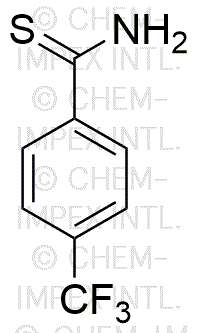4-(Trifluoromethyl)thiobenzamide is widely utilized in research focused on:
- Pharmaceutical Development: This compound serves as a key intermediate in the synthesis of various pharmaceuticals, particularly those targeting specific biological pathways due to its unique trifluoromethyl group, which enhances metabolic stability.
- Agricultural Chemistry: It is used in the formulation of agrochemicals, including pesticides and herbicides, where its properties help improve efficacy and reduce environmental impact compared to traditional compounds.
- Material Science: The compound is explored in the development of advanced materials, such as polymers and coatings, benefiting from its chemical stability and ability to modify surface properties.
- Analytical Chemistry: It is employed as a reagent in various analytical techniques, aiding in the detection and quantification of other chemical species due to its distinctive spectral properties.
- Research in Organic Synthesis: This chemical is a valuable building block in organic synthesis, enabling chemists to create complex molecules more efficiently, thus streamlining research and development processes.
General Information
Properties
Safety and Regulations
Applications
4-(Trifluoromethyl)thiobenzamide is widely utilized in research focused on:
- Pharmaceutical Development: This compound serves as a key intermediate in the synthesis of various pharmaceuticals, particularly those targeting specific biological pathways due to its unique trifluoromethyl group, which enhances metabolic stability.
- Agricultural Chemistry: It is used in the formulation of agrochemicals, including pesticides and herbicides, where its properties help improve efficacy and reduce environmental impact compared to traditional compounds.
- Material Science: The compound is explored in the development of advanced materials, such as polymers and coatings, benefiting from its chemical stability and ability to modify surface properties.
- Analytical Chemistry: It is employed as a reagent in various analytical techniques, aiding in the detection and quantification of other chemical species due to its distinctive spectral properties.
- Research in Organic Synthesis: This chemical is a valuable building block in organic synthesis, enabling chemists to create complex molecules more efficiently, thus streamlining research and development processes.
Documents
Safety Data Sheets (SDS)
The SDS provides comprehensive safety information on handling, storage, and disposal of the product.
Product Specification (PS)
The PS provides a comprehensive breakdown of the product’s properties, including chemical composition, physical state, purity, and storage requirements. It also details acceptable quality ranges and the product's intended applications.
Certificates of Analysis (COA)
Search for Certificates of Analysis (COA) by entering the products Lot Number. Lot and Batch Numbers can be found on a product’s label following the words ‘Lot’ or ‘Batch’.
*Catalog Number
*Lot Number
Certificates Of Origin (COO)
This COO confirms the country where the product was manufactured, and also details the materials and components used in it and whether it is derived from natural, synthetic, or other specific sources. This certificate may be required for customs, trade, and regulatory compliance.
*Catalog Number
*Lot Number
Safety Data Sheets (SDS)
The SDS provides comprehensive safety information on handling, storage, and disposal of the product.
DownloadProduct Specification (PS)
The PS provides a comprehensive breakdown of the product’s properties, including chemical composition, physical state, purity, and storage requirements. It also details acceptable quality ranges and the product's intended applications.
DownloadCertificates of Analysis (COA)
Search for Certificates of Analysis (COA) by entering the products Lot Number. Lot and Batch Numbers can be found on a product’s label following the words ‘Lot’ or ‘Batch’.
*Catalog Number
*Lot Number
Certificates Of Origin (COO)
This COO confirms the country where the product was manufactured, and also details the materials and components used in it and whether it is derived from natural, synthetic, or other specific sources. This certificate may be required for customs, trade, and regulatory compliance.


